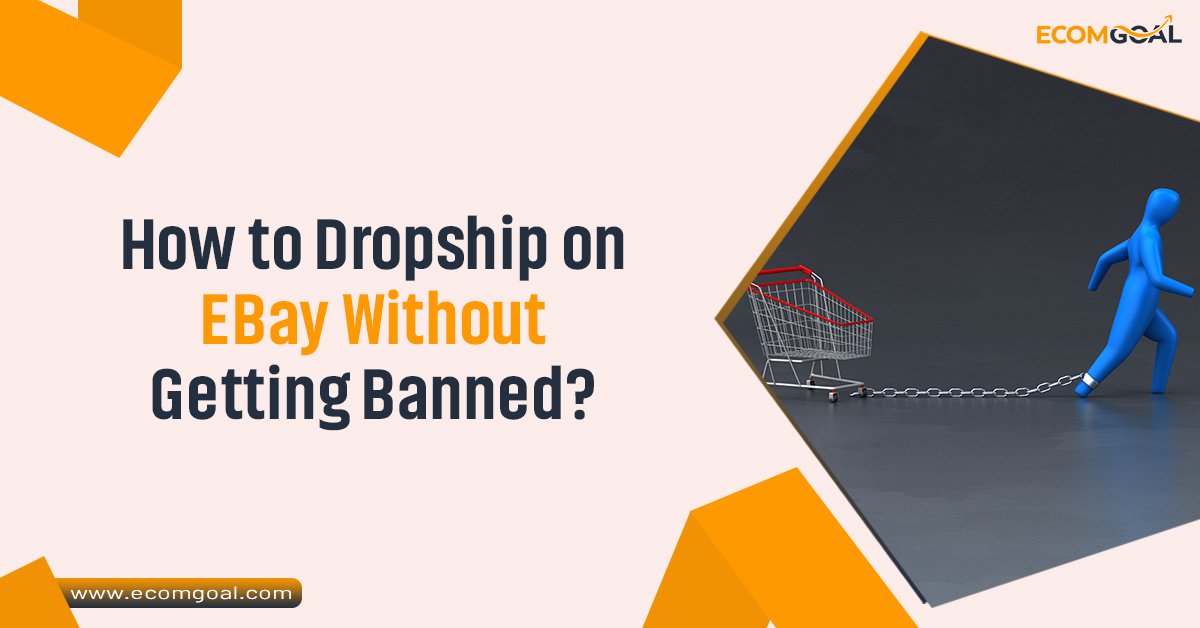
How to dropship on eBay without getting banned? Dropshipping on eBay has become a popular business model due to its low upfront costs and minimal inventory requirements. However, eBay has specific rules regarding dropshipping, and failing to adhere to them can result in account suspension or bans. In this guide, we’ll walk you through how to dropship on eBay without getting banned, legally and safely.
What Is Dropshipping?
Dropshipping is a fulfillment method where you list products online and only purchase them from a supplier once a customer places an order. The supplier then ships the product directly to the customer, eliminating the need for you to hold inventory. This model allows you to focus on marketing and customer service, with the supplier handling logistics.
Why Do People Get Banned for Dropshipping on eBay?
eBay has strict policies regarding dropshipping, primarily because it wants to maintain high levels of customer satisfaction. The platform’s main concern is that sellers using third-party suppliers can’t always guarantee consistent service, which may lead to issues with shipping times, item quality, or order accuracy. Violations often stem from:
- Using other online retailers like Amazon or Walmart as suppliers. eBay strictly prohibits this, as it leads to inconsistencies in quality and customer service.
- Failing to meet eBay’s shipping and handling times. Slow or unreliable shipping can lead to negative customer experiences, which eBay tries to avoid.
- Inadequate customer service. Handling returns, refunds, and customer inquiries is critical for eBay sellers, and failing to maintain a professional customer service experience can result in penalties.
To dropship on eBay successfully, follow these essential steps.
How to Dropship on eBay Without Getting Banned
Step 1: Find Reliable Suppliers
One of the key aspects of dropshipping on eBay without getting banned is choosing reliable suppliers who can provide quality products and meet your shipping time requirements. Avoid large retail platforms, as using them for dropshipping violates eBay’s terms of service. Instead, consider:
- Wholesale suppliers: These suppliers sell products in bulk at a lower cost, allowing you to make a profit on each sale.
- Dropshipping platforms like AliExpress, SaleHoo, or Doba: These platforms connect you with suppliers who are experienced in dropshipping.
- Local suppliers or manufacturers: Partnering with local suppliers may give you faster shipping times and more control over product quality, which can enhance your store’s reputation on eBay.
Verify each supplier’s reputation, response times, shipping times, and product quality. Some platforms, such as SaleHoo, provide vetted suppliers, which can help reduce risk.
Step 2: Set Up a Professional e-Bay Store
Creating a professional eBay store helps establish credibility. A well-structured store with detailed product listings and high-quality images builds trust with potential buyers and helps you stand out.
Here’s how to optimize your eBay store for dropshipping:
- Choose a niche: Focus on a specific product category to attract a target audience and become a trusted seller in that niche.
- Write detailed product descriptions: Include information on product specifications, dimensions, and materials. Accurate descriptions reduce the likelihood of returns and negative reviews.
- Use professional images: Use high-resolution images of your products, preferably from multiple angles, to give buyers a clear idea of what they’re purchasing.
Additionally, ensure your store policies (returns, shipping, etc.) are clearly stated. Transparency can help avoid misunderstandings that may lead to negative feedback or account issues.
Step 3: Manage Your Inventory and Listings
Inventory management is critical in dropshipping, especially when you don’t control stock directly. Many dropshippers face issues when items go out of stock, which can frustrate customers and lead to account penalties.
Consider these tips to manage your inventory effectively:
- Use an inventory management tool: Software like DSM Tool or AutoDS can sync your eBay store with suppliers and automatically adjust your listings if items go out of stock.
- Limit the number of listings: When starting, it’s better to focus on a smaller number of listings and ensure each one is high quality. As you grow, you can expand your catalog while maintaining control over stock and product availability.
Step 4: Offer Excellent Customer Service
Customer service plays a vital role in eBay’s assessment of sellers. Poor customer experiences can lead to bad reviews, disputes, and account issues. Addressing customer inquiries promptly and professionally can prevent these issues.
- Respond quickly to inquiries: Buyers often have questions about shipping, returns, or product details. Aim to respond between 24 hours to foster a positive impression.
- Manage returns efficiently: Develop a straightforward returns policy and work closely with your supplier to handle returns and exchanges smoothly. Quick & hassle-free returns can significantly improve customer satisfaction.
- Be proactive with updates: If there’s a delay or issue with a shipment, inform the buyer immediately. Buyers appreciate transparency and are more forgiving if they’re kept in the loop.
Step 5: Maintain eBay’s Performance Metrics
eBay monitors several performance metrics to assess sellers’ reliability. Meeting or exceeding these metrics is essential to avoid getting flagged by eBay’s system. Key metrics include:
- On-time shipping rate: Keep a high percentage of orders shipped on time by coordinating closely with suppliers.
- Transaction defect rate: Avoid cancellations and unresolved cases, which can damage your defect rate.
- Customer satisfaction: Ensure a low percentage of returns and cases closed without seller resolution to keep your account in good standing.
Using tracking numbers for shipments also helps verify on-time deliveries, which can improve your performance metrics.
Step 6: Stay Updated on eBay’s Policies
eBay’s dropshipping policies can change periodically, so it’s crucial to stay informed about any updates. Ignorance of policy changes can lead to unintentional violations and put your account at risk.
- Regularly check eBay’s seller policies: Familiarize yourself with the latest updates on dropshipping rules, shipping policies, and customer service requirements.
- Participate in eBay community forums: Engage with other sellers and participate in eBay’s forums, where updates and best practices are often shared.
- Stay subscribed to eBay’s newsletters: eBay often sends updates to sellers via email, and these can be valuable in helping you avoid potential violations.
Step 7: Optimize for SEO and eBay Search
Optimizing your listings for eBay search is essential for visibility & sales. Good SEO practices also contribute to a professional image, making you appear more trustworthy.
- Use relevant keywords: Research keywords that buyers are likely to search for, and include them naturally in your titles and descriptions.
- Craft compelling titles: Write titles that are clear and keyword-rich without being overly stuffed. For example, “Wireless Bluetooth Earbuds with the Noise Cancellation” is better than “Earbuds Bluetooth Wireless.”
- Optimize images: Use high-quality, clear images with proper labeling. eBay’s algorithm favors listings with multiple, & clear photos.
- Offer competitive pricing: Price competitively by checking the price range of similar products. Remember to factor in shipping costs and fees when setting prices.
Step 8: Track and Adjust Your Strategy
The dropshipping landscape, like any business, requires constant adaptation. Monitor your sales, customer feedback, and eBay metrics to refine your approach over time.
- Use analytics tools: eBay’s Seller Hub provides insights into your store’s performance. Monitor your sales, conversion rates, & other metrics to identify areas for improvement.
- Experiment with pricing and promotions: Test different pricing strategies or promotional offers to see what works best for your audience. Promotions can boost visibility and attract more buyers.
- Adjust product selection: If certain items aren’t selling well, consider replacing them with more popular options. Regularly update your catalog based on demand trends.
Conclusion
How to dropship on eBay without getting banned is entirely possible if you follow the platform’s policies and focus on providing quality customer experiences. By choosing reliable suppliers, maintaining good customer service, optimizing for SEO, and staying compliant with eBay’s rules, you can build a successful and sustainable dropshipping business. Remember that eBay is highly customer-focused, so prioritizing customer satisfaction should always be at the core of your strategy.

Hello, I am an E-commerce Expert with extensive experience providing services to numerous e-commerce brands and individuals since 2017. My primary areas of expertise include the Amazon, Walmart, and Shopify marketplaces. Linkedin
